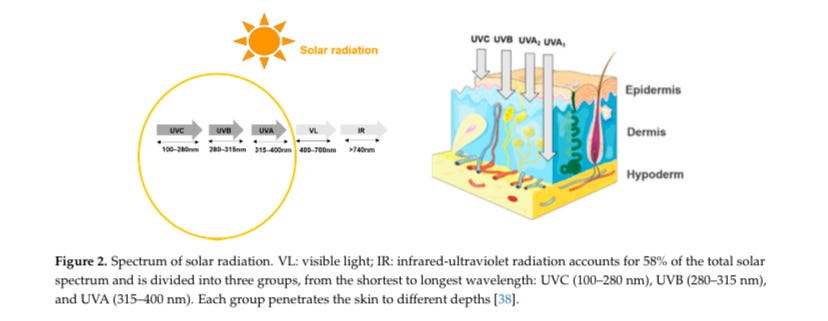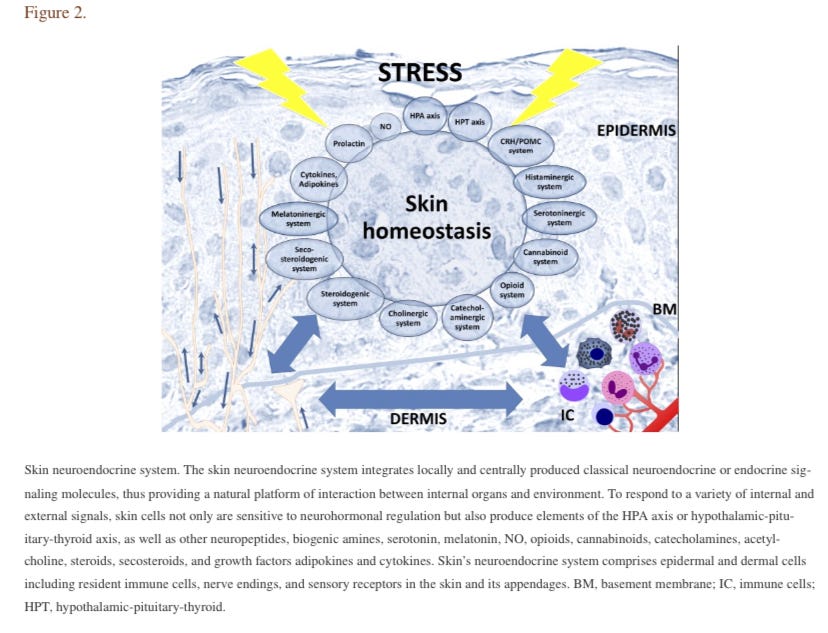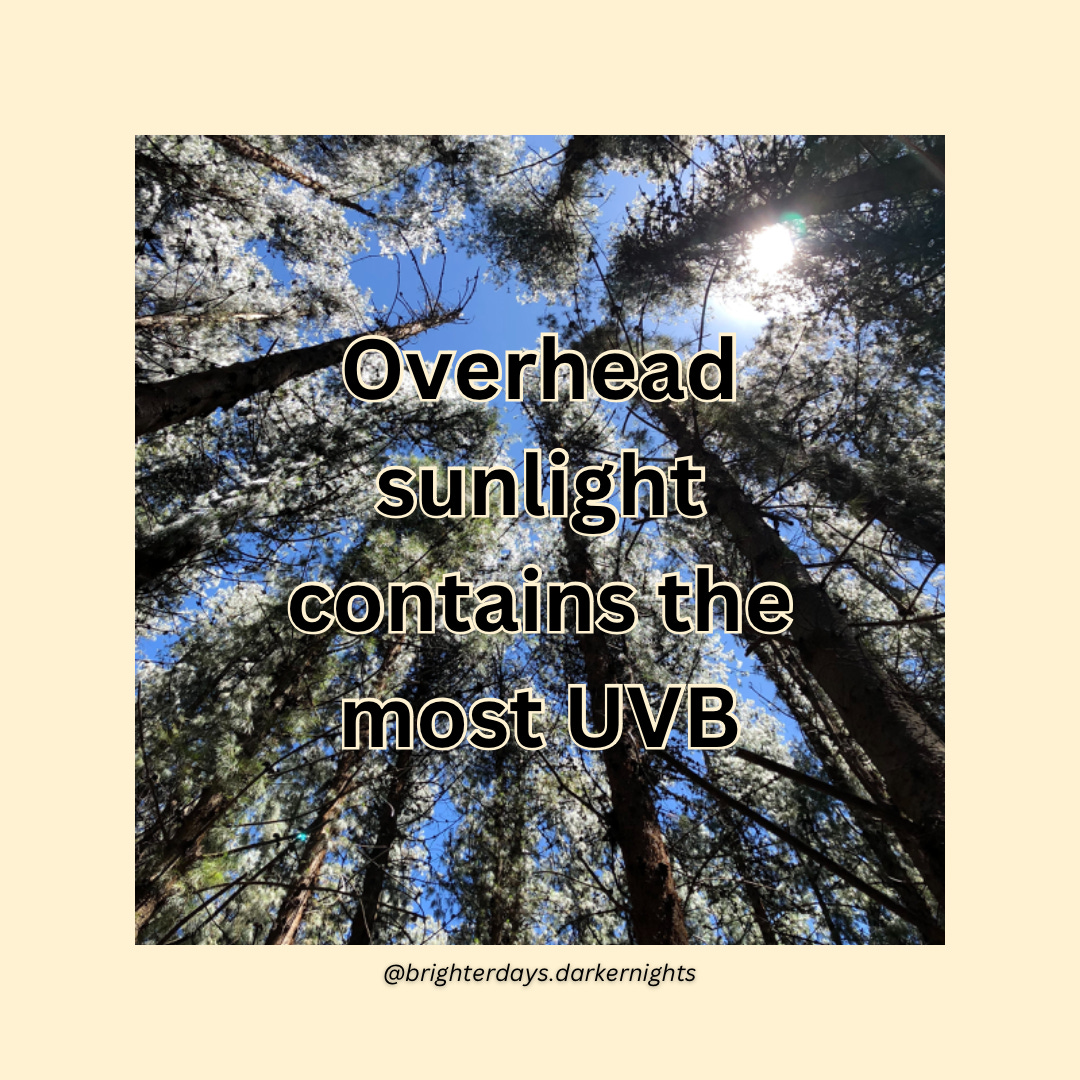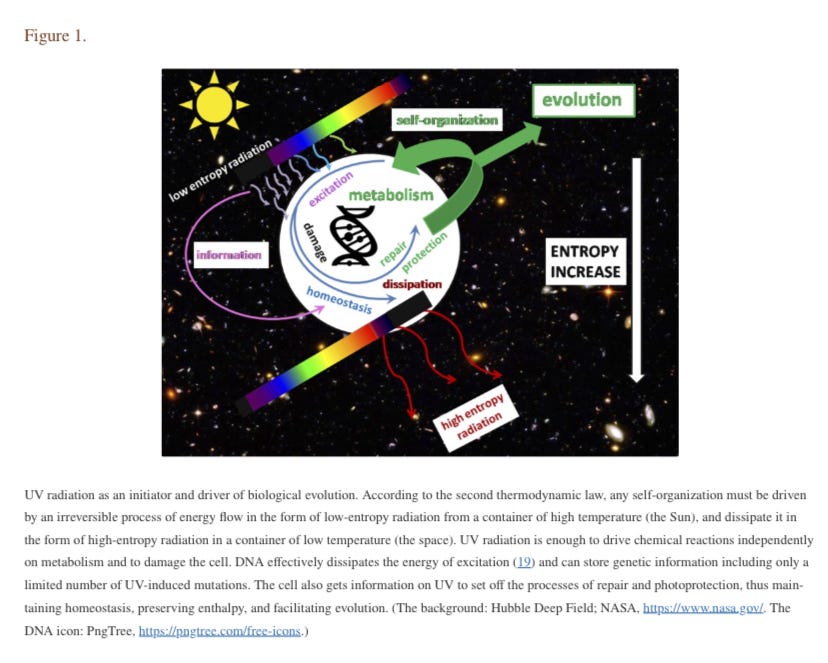U need UV!
It does more than Vitamin D.
The ultraviolet (UV) part of sunshine has a bad reputation in mainstream medicine. If you have ever experienced severe sunburn or heat exhaustion, you may fear it at a visceral level! At the same time, we need UV for our wellbeing.
Did you know skin cells respond to sunlight1 and produce:
neuropeptides
biogenic amines
serotonin
melatonin
nitric oxide
opioids
cannabinoids
catecholamines
acetylcholine
steroids
secosteroids
adipokines and cytokenes
And that sunligh on the skin helps regulate all these sub-categories of our neuroendocrine system?
melatoninergic system
secosteroidogenic system
steroidogenic system
cholinergic system
catecholaminergic system
opioid system
cannabinoid system
serotoninergic system
histaminergic system
CRH/POMC system
HPA axis
HPT axis
If you are like I was when I started down this research track, you might not yet even recognize all these names! Let alone know that sunlight on the skin could be responsible for so much.
The skin is a neuroendocrine organ—meaning it communicates between the nervous system and the endocrine system, translating light signals from outside into messages and directions to the body’s internal regulatory systems.
There is far too much to research on the topic of healthy ultraviolet light cover in this one email (the main paper I am pulling from in this post contains well over 200 citations).
On the more actionable side, I like to use Dminder to measure out my daily safe UV exposure. This is one way to be sure of the benefits while minimizing sunburn and skin damage.
I wrote about using dminder and other things you can do to build a strong solar callus earlier this year:
The rest of this post is about the science behind deliberate UV exposure.
First of all, we have to talk about mainstream medicine.
Why is the public health industry as a whole against solar exposure? If you read their own literature, it is quite easy to find statements such as:
“[E]xcessive UVR exposure accounts for only 0.1% of the total global burden of disease in disability-adjusted life years (DALYs), according to the 2006 World Health Organization (WHO) report The Global Burden of Disease Due to Ultraviolet Radiation… In contrast, the same WHO report noted that a markedly larger annual disease burden of 3.3 billion DALYs worldwide might result from very low levels of UVR exposure2.”
Source: Benefits of Sunlight: A Bright Spot for Human Health
But it all becomes clear when you look at modern pharmaceuticals. Modern doctors are in the business of selling modern prescriptions. And modern drugs, by and large, make people more sensitive to the sun! According the the FDA’s 1990 report, Medications that Increase Sensitivity to Light:
“In addition to an exaggerated skin burn, itching, scaling, rash, or swelling, exposure to ultraviolet light in combination with certain medications may result in skin cancer, premature skin aging, skin and eye burns, allergic reactions, cataracts (clouding in the eyes), reduced immunity, and/or blood vessel damage3.”
Source: Jerome I. Levine, M.S., R.Ph.
See below for an overview of drug categories that increase photosensitivity as reported by the FDA.
(By the way: if you happen know of a more comprehensive list of photosensitizing medications, please send it to me! This report I have been able to find is over 30 years old.)
Here are the medication categories known to cause photosensitivity:

Antihistamines
Examples of antihistamines responsible for photosensitizing reactions: Astemizole, Azatadine, Brompheniramine, Buclizine, Carbinoxamine, Chlorphenaramine, Clemastine, Cyclizine, Cyproheptadine, Dexchlorpheniramine, Dimenyhydrinate, Diphenhydramine, Diphenylpraline, Doxylamine, Hydroxyzine, Meclizine, Methapyrilene, Ophenadrine, Pheniramine, Promethazine, Pyrilamine, Terfenadine, Trimeprazine, Trepelennamine, Triprolidine, and others.
Coal and tar derivatives
Examples of coal and tar derivatives responsible for photosensitizing reactions: Alphosyl, Aquatar, Denorex Medicated Shampoo, DHS Tar Gel Shampoo, DOAK Shampoo, Estar, Ionil T Plus, LAVATAR, Medotar, T/Derm Tar Emollient, Tegrin Shampoo, T/Gel Therapeutic Shampoo, Zetar Shampoo, and others.
Contraceptives, oral and estrogens (birth control pills, female sex hormones)
Examples of contraceptives responsible for photosensitizing reactions: Estrogens (Chlorotrianisene, Diethylstilbestrol, Estradiol, Estrogens, conjugated, Estrogents, esterified, Estropipate and others), Progestogens (Ethinyl estradiol, Medroxyprogesterone, Megestrol, Norethindrone, Norgestrel, Quinestrol, and others).
Non-steroidal Anti-inflammatory Drugs (antiarthritics)
Examples of NSAIDs responsible for photosensitizing reactions: Diclofenac, Diflunisal, Fenoprofen, Flubiprofen, Ibuprofen, Idomethacin, Ketoprofen, Meclofenemate, Naproxen, Phenylbutazone, Piroxicam, Sulinad, Suprofen, Tolmetin and others.
Phenothiazines (major tranquilizers, anti-emetics)
Phenothiazines responsible for photosensitizing reactions: Acetophenazine, Butaperazine, Carphenazine, Chlorpromazine, Ethopropazine, Phuphenazine, Mesoridazine, Methdilazine, Methotrimeprazine, Perphenazine, Piperacetazine, Prochloroperazine, Promazine, Promethazine, Proiomazine, Thiethylperazine, Thioridazine, Trifluoperazine, Triflupromazine, Trimeprazine, and others.
Psoralens
Psoralens responsible for photosensitizing reactions: Methoxsalen, Trioxsalen, and others.
Sulfonamides (“sulfa” drugs, antimicrobials, anti-infectives)
Sulfonamides responsible for photosensitizing reactions: Acetazolamide, Sulfacytine, Sulfadiazine, Sulfadoxine, Sulfamethizole, Sulfamethoxazole, Sulfapyridine, Sulfasalazine, Sulfinpyrazone, Sulfisoxazole, and others.
Sulfonylureas (antidiabetics, hypoglycemics)
Sulfonlureas responsible for photosensitizing reactions: Acetohexamide, Chlorpropamide, Glipizide, Glyburide, Tolazamide, Tolbutamide, and others.
Thiazide Diuretics (“water pills”)
Water pills responsible for photosensitizing reactions: Bendroflumethiazide, Benzthiazide, Chlorothiazide, Chlorthalidone, Cyclothiazide, Hydrochlorothiazide, Hydroflumethiazide, Methyclothiazide, Molythiazide, Trichlormethiazide, and others.
Tetracyclines (antibiotics, anti-infectives)
Antibiotics responsible for photosensitizing reactions: Chlortetracycline, Demeclocycline, Doxycycline, Methacycline, Minocycline, Oxytetracycline, Tetracycline, and others.
Tricyclic Antidepressants
Antidepressants responsible for photosensitizing reactions: Amitriptyline, Amoxapine, Desipramine, Doxepin, Imipramine, Nortriptyline, Protriptyline, Trimipramine, and others.
You can read the full report here:
The good news is that our skin understands light of all kinds. If UV light may not work for you at present, you can still use darkness and infrared for healing.
When it comes to UV light, the melanocyte is the main “computer” that receives the UV signals from the environment:
Of course Vitamin D, or, "steroid hormone D", is the most famous effect of UV light landing on the skin. I could have written this whole post about the positive effects of Vitamin D, but instead, look at all the other things skin makes under UV light4:
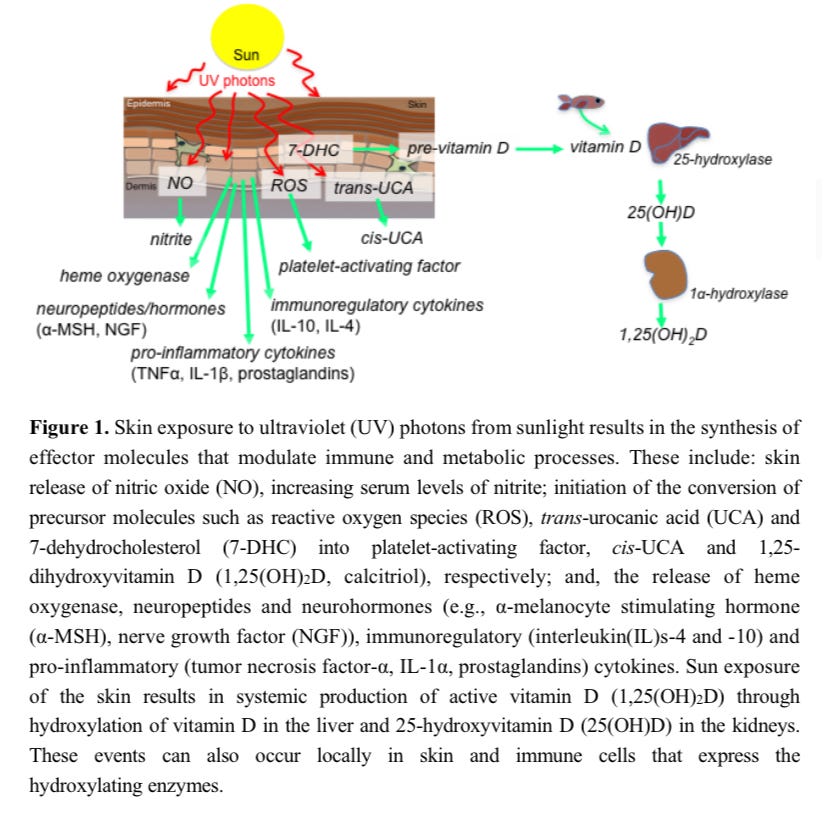
I find this all to be super fascinating! I love reading this information and trying to put it into the context of living a good life. And you know what feels good? Sunbathing. Working outdoors. Taking a walk or a bike ride. Patio dining. Rolling the windows down in the car on a breezy sunny day.
There are so many joyful ways to get more UV... and doesn't knowing all this science make it make all the more sense why it should feel so good? To zoom way, way, way out, some biologists consider UV a primary initiator and driver of evolution:
So who knows. Could your time outside could cause the next great leap in humanity's development?
What are your favorite ways to get more sunshine into your day? Login to let us know in the comments!



